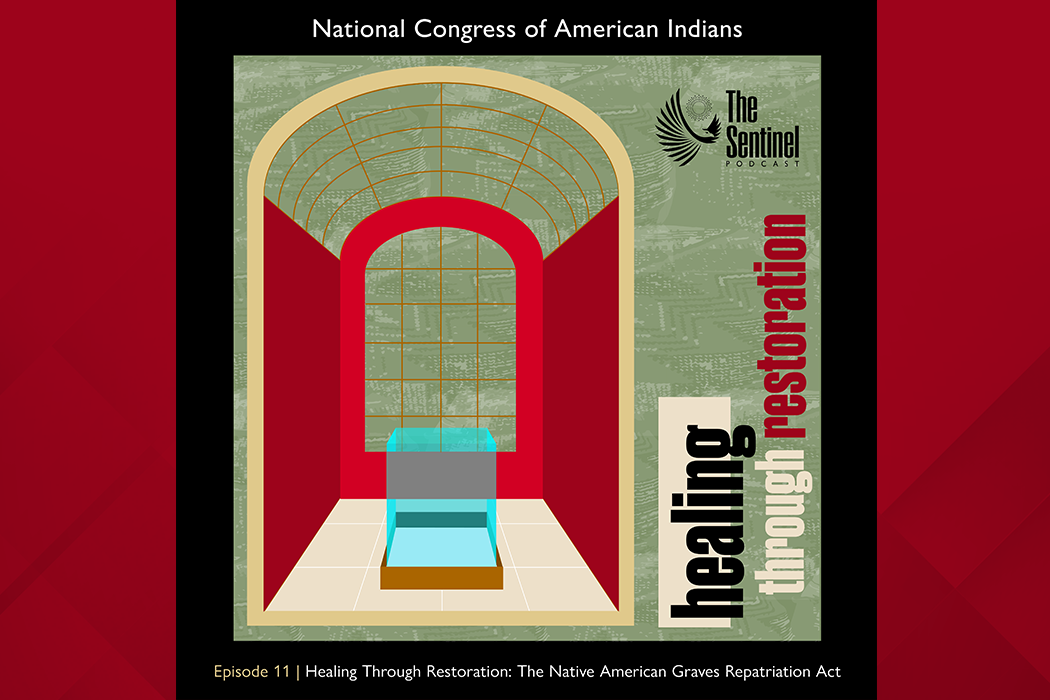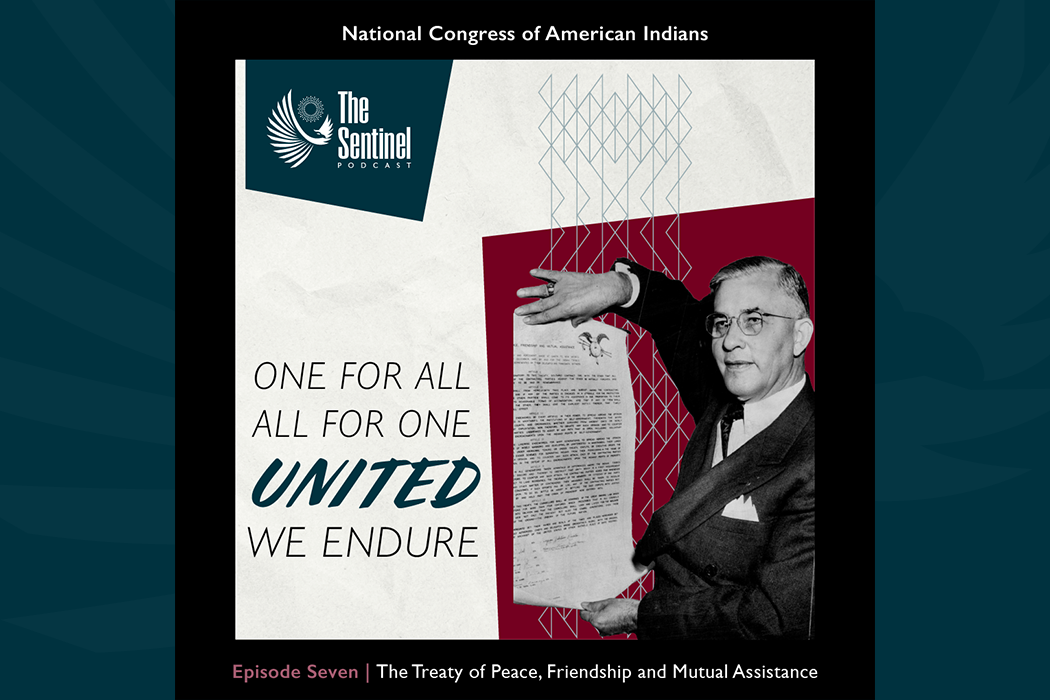
The Native American Graves Repatriation Act (NAGPRA) addresses the treatment and repatriation of cultural items, objects of cultural patrimony, sacred objects, and human remains. Passed into law in 1990 as a result of decades of NCAI advocacy, this legislation goes a long way towards recognizing and respecting the sacred, religious, and cultural rights of American Indian and Alaska Native people. It was considered long overdue at the time of its passage and has faced significant hurdles since then.
One of the key provisions of NAGPRA establishes requirements that federal agencies and any institutions that receive federal funding, make account of any human remains, funerary objects, sacred objects, and objects of cultural patrimony that they have in their possession. The law states that they must be then repatriated to the appropriate Tribal Nations, to be cared for, and to be honored according to tribal religious practices.
Of critical importance is that NAGPRA also includes steps for consultation and collaboration between federal agencies, museums, and Tribal representatives and communities. One of its goals is to foster communication based on respect for culture and cultural sensitivity. This process is meant to bring healing and reconciliation to Native communities. Likewise, it calls for both museums and cultural institutions to address and take stock of the historical trauma associated with the exploitation and desecration of sacred objects, burial sites, and human remains that were stolen for their own benefit.
Delving back into the NCAI archival records, we learn that the organization was a key advocate for repatriation legislation long before NAGPRA was adopted. For example, In 1986 at the Annual Convention in Phoenix, Arizona, NCAI condemned the Department of Interior policy on human remains and sacred objects that they had developed without any tribal consultation or input. Organization leaders called on Congress to create tribally focused legislation, and to “hold hearings to allow the Indian Community to present its views and recommendations.”
Then, immediately prior to the passage of NAGPRA, NCAI adopted a Resolution at the 1990 Executive Council Winter Session calling upon Congress to adopt repatriation legislation because, “the sanctity of the dead for American Indians and Alaska Natives has never been respected by the dominant, non-Indian society as evidenced by the untold thousands of deceased Native Americans that have been dug up from their final resting places and because respect for the dead is a basic human right that is fundamental to all cultures, societies and religions…”.
Working in coalition with its partners such as the Native American Rights Fund and Association on American Indian Affairs, NCAI continued its unwavering advocacy until NAGPRA was finally passed into law in November 1990. Unfortunately, despite its historic significance, NAGPRA has faced major challenges in its implementation. Many claim that the original legislation does not go far enough to address past wrongdoings, nor does it take into account the challenges of the repatriation process both in terms of legal and ethical considerations. The quest for successful implementation of NAGPRA has dragged on for 34 years.
In recent months, however, there have been some promising developments. In an April 2023 press release, NCAI commended the ongoing bipartisan effort of the U.S. Senate that was underway at the time for ensuring that, “Native American ancestral remains and cultural items are returned to their rightful owners as an essential first step towards acknowledging the historic and ongoing wrongs inflicted upon the American Indian and Alaska Native community.” In August 2023, the National Park Service announced $3.4 million in grants to 16 Tribal Nations and 28 museums to assist in the consultation, documentation, and repatriation of ancestral remains and cultural items. This is the largest amount since the grant program began.
Lastly, on December 6, 2023, the Department of the Interior announced the outcome of that work—a series of new, stricter regulations concerning the implementation of NAGPRA. The new rules are considered long overdue and are a result of Nation-to-Nation consultation. They strengthen the force of the law and include systematic processes for returning human remains, funerary objects, and objects of cultural patrimony, setting the timeline for compliance at 5 years. The goal of the regulations is to give Tribal Nations more authority in the repatriation process. Museums and federal agencies now must obtain free, prior, and informed consent from Tribal Nations and descendants before displaying or conducting research on any human remains or cultural items. In addition, museums must now be more publicly transparent about their collection holdings that are subject to NAGPRA.
News coverage across the country has reported on the response to the new NAGPRA changes announcing that museums and cultural institutions have either covered or removed their exhibits relating to Native history. For example, The American Museum of Natural History in New York closed two halls dedicated to the Eastern Woodlands and Great Plains tribal cultures. Sean Decatur, President of the Museum, explained, “The Halls we are closing are vestiges of an era when museums did not respect values, perspectives and indeed the shared humanity of indigenous peoples.”
Other institutions have responded accordingly and have removed objects on display as they await consultation with Tribal Nations. We have yet to completely see how these new regulations will play out. But the hope is they will fulfill the original intent of the legislation and not result in further delays. Secretary of the Interior Deb Haaland stated, “The Native American Graves Protection and Repatriation Act is an essential tool for the safe return of sacred objects to the communities from which they were stolen. Among the updates we are implementing are critical steps to strengthen the authority and role of Indigenous communities in the repatriation process…. Finalizing these changes are an important part of laying the groundwork for the healing of our people.”
As time goes on, NCAI will continue to advocate for the complete implementation of NAGPRA and repatriation of ancestral remains, and sacred and cultural objects, so that wrongdoings inflicted upon American Indian and Alaska Native communities are recognized and healing can begin.
About the Sentinel Blog
The Sentinel signals a rebirth of NCAI’s oldest and most continuously published membership newsletter, The NCAI Sentinel. Published for the first time in the 1940s, The Sentinel focused on NCAI membership matters, events, people and policy issues. This newly conceived version will, instead, take a look backwards with a nod to the present. Each post will feature stories about past events, programs, and people, as well as articles on NCAI leaders throughout the years and new developments and discoveries in the archival collections.
Drawing on NCAI’s rich digital and physical archival collections, it is our hope that you will return each month to learn more about the organization’s 80 years of advocacy for Indian Country and, as a result, will also remain informed about what is happening at NCAI today.


